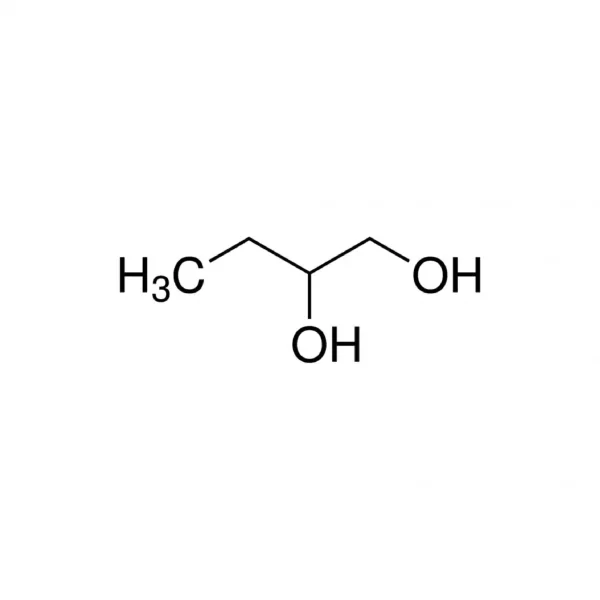
1,2-Butanediol purum, ≥98.0% (GC) (Sigma)
Login to see pricesBrand:
Sigma
Description
Grade: Purum
Assay: ≥98.0% (GC)
Synonym: 1,2-Butylene glycol
1,2-Butanediol has been used:

2,2-Diphenyl-1-picrylhydrazyl – Sigma – Aldrich
Login to see pricesBrand:
Sigma-Aldrich
Description
CAS Number: 1898-66-4
Molecular weight : 394.32 g/mol
Empirical formula : C18H12N5O6
Synonyms : 1,1-Diphenyl-2-picrylhydrazyl radical, 2,2-Diphenyl-1-(2,4,6-trinitrophenyl)hydrazyl, DPPH
2,2-diphenyl-1-picrylhydrazyl is a type of free radical that can accept hydrogen from antioxidants, making it a useful tool in the DPPH assay for evaluating the antioxidant activity of various natural samples, including wine, fruits, and herbal tea.
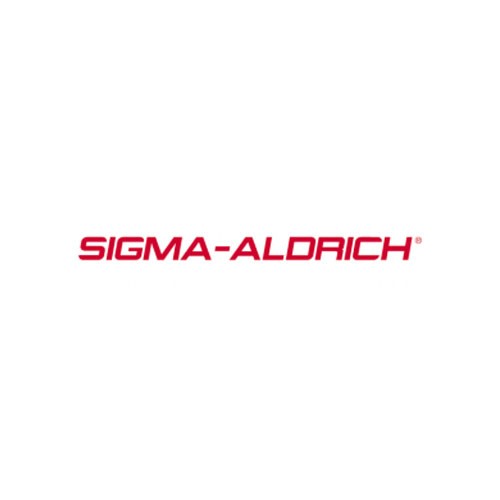
3-Chloroperbenzoic acid, ≤77% (Sigma-Aldrich)
Login to see pricesBrand:
Sigma-Aldrich
Description:
CAS number: 937-14-4
Chemical Formula: ClC6H4CO3H
Molar Mass: 172.57 g/mol
Synonyms: 3-Chloroperoxybenzoic acid, meta-Chloroperbenzoic acid, MCPBA
General description
3-Chloroperbenzoic acid is a strong oxidizing agent mainly used for the epoxidation of alkenes and also in the Baeyer-Villiger oxidation of ketones to esters.
Application
3-Chloroperbenzoic acid has been used in the oxidation of N–p-tolylsulfinyl-(E)-1-phenylethylideneimine to N–p-tolylsulfonyl (E)-1-phenylethylideneimine using dichloromethane as a solvent. It has also been used in the preparation of mono- and di-epoxy-functionalized poly(3-hydroxybutyrate)-based reactive polymers. MCPBA is also an effective oxidizing agent for the conversion of α-amide substituted polyesters to their corresponding polysulfones with tunable thermal properties.
Effective oxidant for epoxidizing di-, tri-, and tetra-substituted olefins.

4-Nitrophenyl butyrate, ≥98% (Sigma-Aldrich)
Login to see pricesBrand:
Sigma-Aldrich
Description
CAS number: 2635-84-9
Chemical Formula: C10H11NO4
Molar Mass: 209.20 g/mol
Synonyms: p-Nitrophenyl butyrate, Butyric acid 4-nitrophenyl ester
General description
4-Nitrophenyl butyrate is a substrate for esterase, and lipase enzyme. Hydrolysis of 4-nitrophenyl butyrate by these enzymes releases the chromophore, 4-nitrophenolate which is spectrophotometrically analysed at 415 nm.
Application
4-nitrophenyl butyrate has been used:
• as a substrate for esterase activity in monocyte-derived macrophage cell line in response to polyethylene
• as a substrate for mycobacterial phospholipase A and mycobacterial cutinase activity
• as a substrate to determine the effect of buffers and solvents on human carboxylesterase

Benzene Anhydrous, 99.8% – Sigma-Aldrich
Login to see pricesBrand:
Sigma-Aldrich
Description
CAS Number: 71-43-2
Empirical Formula: C6H6
Molecular Weight: 78.11
Synonyms: –
Assay: 99.8%
Benzene is a six-membered aromatic compound that can undergo ionization induced by superhalogens, according to ab initio calculations. This compound is a frequently used industrial solvent but is also considered an air pollutant and a powerful carcinogen.
Benzene may be used in the formation of phenyl acetate by aerobic oxidation using Pd catalyst and acetic acid as solvent, formation of phenol by hydroxylation in the presence of mesoporous carbon nitride supported on vanadium catalyst and as a solvent to prepare nanoparticles of gallium nitride (GaN) by reacting Li3N and GaCl3 at 280°C.
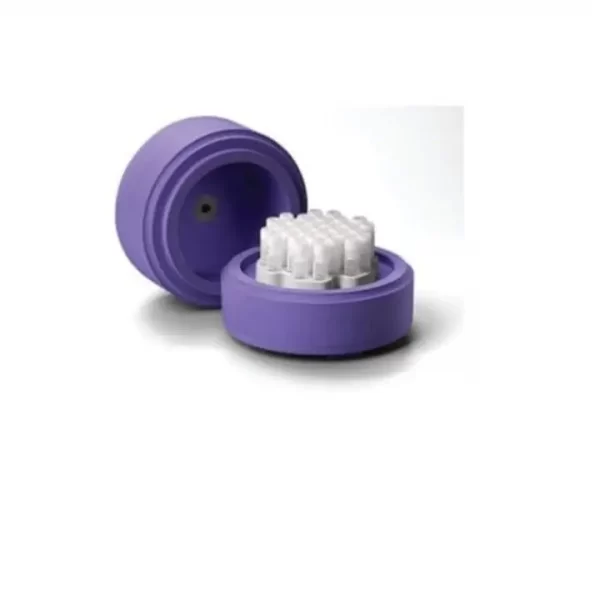
Corning® CoolCell™ FTS30 (Sigma-Aldrich)
Login to see pricesBrand:
Sigma
Description
CoolCelll FTS30 utilizes a solid state core and controlled microconvection technology to evenly draw in -80°C freezer air through a bottom base vent, uniformly disperse the cold air around each vial in the central chamber and then release the thermal load from the vials through a top vent choke. The inner vial module holds 30 cryogenic vials and can be removed in one step. Each vial achieves a uniform and reproducible -1°C/minute freezing profile and thermal profiles are highly reproducible. Due to the low thermal mass of the uniform-density cross-linked polyethylene foam container, freezing can be conducted without a rise in local freezer temperature, thereby protecting nearby samples.
Application :
-For 30 standard 1.0 mL to 2.0 mL cryogenic vials.
-Controlled micro-convection for uniform freezing of 30 vials.
-Removable vial tray for one-step transfer of samples into and out of freezing chamber.

Cycloheximide from microbial, ≥ 94% (TLC) (Sigma-Aldrich)
Login to see pricesBrand:
Sigma-Aldrich
Description
CAS number: 66-81-9
Chemical Formula: C15H23NO4
Molar Mass: 281.35 g/mol
Synonyms: 3-[2-(3,5-Dimethyl-2-oxocyclohexyl)-2-hydroxyethyl]glutarimide, Actidione, Naramycin A
Application
In yeast strains, cycloheximide has been used as a protein synthesis inhibitor in the cycloheximide chase experiment. It has been used to inhibit translation in mammalian cells and suppress fungal growth.
Biochem/physiol Actions
Cycloheximide (CHX) is an antibiotic produced by S. griseus. Its main biological activity is translation inhibition in eukaryotes resulting in cell growth arrest and cell death. CHX is widely used for selection of CHX-resistant strains of yeast and fungi, controlled inhibition of protein synthesis for detection of short-lived proteins and super-induction of protein expression, and apoptosis induction or facilitation of apoptosis induction by death receptors.

Dimethyl Sulfoxide, Anhydrous, ≥99.9% (Sigma-Aldrich)
Login to see pricesBrand:
Sigma-Aldrich
Description
CAS number: 67-68-5
Linear Formula: (CH3)2SO
Molecular Weight 78.13
Synonym: DMSO
General description
Dimethyl Sulfoxide (DMSO) is an apolar protic solvent that is generally used as a reaction medium and reagent in organic reactions.
Application
Dimethyl Sulfoxide may be used as an oxidant for the conversion of isonitriles into isocyanates. DMSO activated by oxalyl chloride can be used in the oxidation of long-chain alcohols to carbonyls.

Dimethyl Sulfoxide, Dimethyl Sulfoxide, Dimethyl Sulfoxide, ≥99.7% (Sigma-Aldrich) – Discontinue99.7% (Sigma-Aldrich) – Discontinued99.7% (Sigma-Aldrich) – Discontinued
Login to see pricesBrand:
Sigma-Aldrich
**This product has been discontinued, please contact us for more information.
Description
CAS number: 67-68-5
Chemical Formula: (CH3)2SO
Molar Mass: 78.13 g/mol
Sterility: Sterile-filtered
Synonyms: DMSO
Application
DMSO is a polar aprotic solvent used in chemical reactions, in polymerase chain reactions (PCR) and as a cryoprotectant vitrification agent for the preservation of cells, tissues and organs. DMSO is used in cell freezing media to protect cells from ice crystal-induced mechanical injury. It is used for frozen storage of primary, sub-cultured, and recombinant heteroploid and hybridoma cell lines; embryonic stem cells (ESC), and hematopoietic stem cells. DMSO is frequently used in the combinations with BSA or fetal bovine serum (FBS).
Other Notes
This product is a Hybri-Max product. It is hybridoma tested and is assessed for suitability in cell freezing. This product is sterile filtered (0.2 micron) and tested for endotoxin levels.

Dimidium bromide, BioReagent, suitable for fluorescence, ~95% (AT), Sigma
Login to see pricesBrand:
Sigma-Aldrich
CAS number: 518-67-2
Chemical Formula: C20H18BrN3
Molar Mass: 380.28 g/mol
Synonyms: 3,8-Diamino-5-methyl-6-phenylphenanthridinium bromide, Trypadine
Application
Intercalating probe for nucleic acids. Suitable for fluorescence.

Dulbecco’s Modified Eagle’s Medium (DMEM), powder form
Login to see pricesBrand:
Sigma-Aldrich
Dulbecco′s Modified Eagle′s Medium (DMEM) is a modification of Basal Medium Eagle (BME) that contains four-fold concentrations of the amino acids and vitamins which suitable for cell culture. The original formulation contained 1000 mg/L of glucose and was used to culture embryonic mouse cells. Since then, it has been modified in several ways to support primary cultures of mouse and chicken cells, as well as a variety of normal and transformed cells. Each of these media offers a different combination of L-glutamine and sodium pyruvate. Refer to the table below and choose your prefered DMEM!

Fetal Bovine Serum non-USA Origin, Sterile-filtered, Suitable for Cell Culture
Login to see pricesBrand:
Sigma
Description
Synonyms: Fetal Calf sera, Fetal Calf serum, FBS, FCS, sera, serum
Fetal calf serum is a common supplement used in cell culture media to promote cell growth and proliferation. It is a non-USA origin fetal calf serum that has been sterile-filtered, making it free from contaminants and suitable for use in cell culture applications. This product is an excellent choice for those looking for a reliable and high-quality fetal calf serum that can support a wide range of cell types in culture.
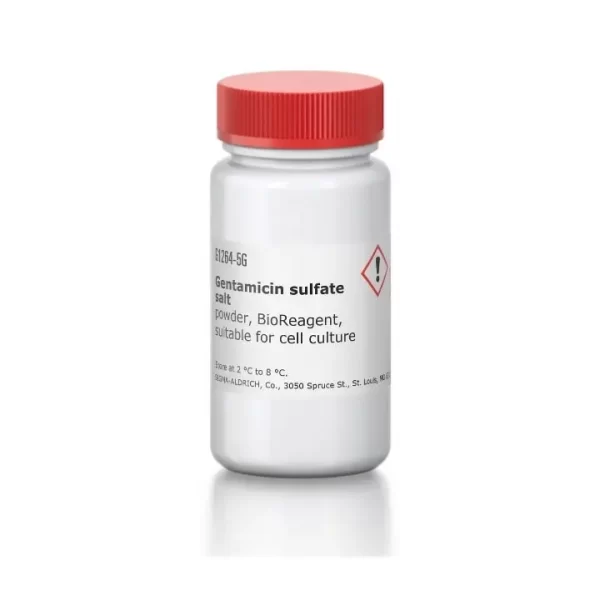
Gentamicin sulfate salt – Sigma-Aldrich
Login to see pricesBrand:
Sigma
Description
Cas Number : 1045-41-0
Synonyms : Gentiomycin C
Chemical structure: aminoglycoside
Gentamicin, also known as gentiomycin C, is an aminoglycoside, which is naturally produced by Gram-negative bacteria. This antibiotic functions by preventing protein synthesis.[1] Gentamicin sulfate prevents the growth of both Gram positive and Gram negative bacteria, in vivo and in vitro. In tissue culture, gentamicin sulfate is used to inhibit the growth of various strains of mycoplasma.[2].
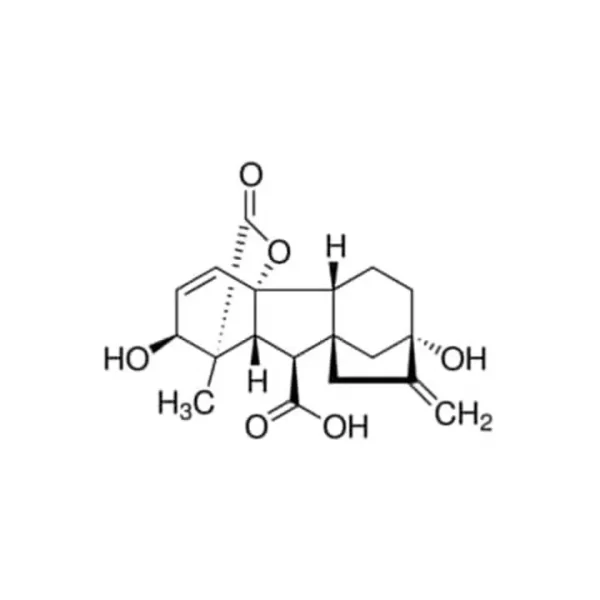
Gibberellin 80% gibberellin A3 basis (TLC) (Sigma-Aldrich)
Login to see pricesBrand:
Sigma
Description
Formula : C19H22O6
Molecular weight : 346.37 g/mol
Synonym : GA3
A “classical” ubiquitous plant hormone, with diverse effects, such as stilumating stem and root growth, and stimulating seed germination.

Glycerol, For Molecular Biology, ≥99.0% (Sigma-Aldrich)
Login to see pricesBrand:
Sigma-Aldrich
Description
CAS number: 56-81-5
Chemical Formula: HOCH2CH(OH)CH2OH
Molar Mass: 92.09 g/mol
Synonyms: 1,2,3-Propanetriol, Glycerin
General description
Glycerol is odourless, colourless, viscous in nature, and exists as a sweet-tasting liquid. It can be derived naturally as well as from petrochemical feedstock. Glycerol has a wide variety of applications and is one of the most valuable and versatile chemical substances in nature. It can be used as an emollient, solvent, sweetening agent, in pharmaceutical formulations, cosmetics, foodstuffs and toiletries. It is very stable and can be easily stored under normal temperature; also it is non-irritating and has no adverse impact on the environment.
Application
Glycerol has been used as:
• A supplement during cell culture of Mycobacterium tuberculosis and Mycobacterium avium.
• A fuel during designing enzymatic biofuel cell.
• A liquid composite matrix with 4-HCCA and 3-aminoquinoline for analysis of neutral and acidic glycans.
• A matrix for fast atom bombardment MS.
• May be employed as liquid matrix for the quantification studies by MALDI (Matrix-assisted laser desorption/ionization mass spectrometry) analysis.
Glycerol is used both in sample preparation and gel formation for polyacrylamide gel electrophoresis. Glycerol (5-10%) increases the density of a sample so that the sample will layer at the bottom of a gel′s sample well. Glycerol is also used to aid in casting gradient gels and as a protein stabilizer and storage buffer component.
Glycerol is used both in sample preparation and gel formation for polyacrylamide gel electrophoresis. Glycerol (5-10%) increases the density of a sample so that the sample will layer at the bottom of a gel’s sample well. Glycerol is also used to aid in casting gradient gels and as a protein stabilizer and storage buffer component.
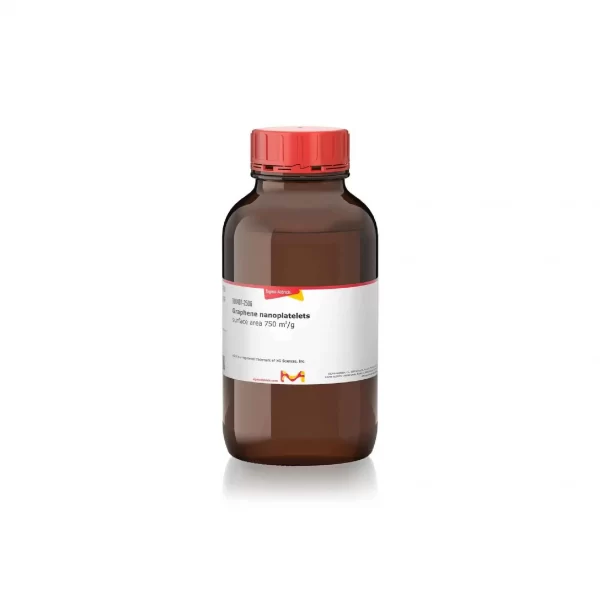
Graphene Nanoplatelets, Sigma – Aldrich
Login to see pricesBrand:
Sigma
Description
CAS number: 7782-42-5
Molecular weight:12.01
Synonyms: GNPs, xGnP® graphene nanoplatelets-grade C-750
xGnP® graphene nanoplatelets are a unique type of nanoparticle that have a platelet shape and are composed of short stacks of graphene sheets. Their distinctive size and morphology make them highly effective at providing barrier properties, as well as excellent electrical and thermal conductors due to their pure graphitic composition. Additionally, incorporating xGnP® graphene nanoplatelets can enhance mechanical properties such as stiffness, strength, and surface hardness of the matrix material.
Applications include:
- Ultracapacitor electrodes.
- Anode materials for lithium-ion batteries.
- Conductive additive for battery electrodes.
- Electrically conductive inks.
- Thermally conductive films and coatings.
- Additive for lightweight composites.
- Films or coatings for EMI shielding.
- Substrate for chemical and biochemical sensors.
- Barrier material for packaging.
- Additive for super-strong concrete.
- Additive for metal-matrix composites.

Histopaque®-1077 (Sigma-Aldrich)
Login to see pricesBrand:
Sigma-Aldrich
General description
Histopaque-1077 is a sterile, endotoxin tested solution of polysucrose and sodium diatrizoate, adjusted to a density of 1.077g/mL. This ready-to-use medium facilitates rapid recovery of viable lymphocytes and other mononuclear cells from small volumes of whole blood.
Application
Haematology: suitable
Histology: suitable
Histopaque-1077 has been used for-
• the isolation of peripheral blood mononuclear cells (PBMCs) and bone marrow mononuclear cells (BMMCs)
• purification of mononuclear cells through centrifugation
• isolation of human lymphocytes
• isolation of breast cancer circulating tumour cells (CTCs) from whole blood

Iron puriss. p.a., carbonyl-Iron powder, low in magnesium and manganese compounds, ≥99.5% (RT)-Sigma-Aldrich
Login to see pricesBrand:
Sigma
Description
Cas Number :7439-89-6
Molecular mass :55.85 g/mol
Chemical formula : Fe
Synonyms : Fe
Iron (carbonyl) powder has been used:
In the preparation of copper on iron (Cu/Fe) bimetallic catalytic system to synthesize β-aminoenones and 3,5-disubstituted pyrazoles.[1]
As the main component of magnetorheological fluids.[2][3]
To produce Fe-B-C composites from boron carbide using plasma sintering.[4]

Litmus Milk, for Microbiology, NutriSelect® Plus, Sigma
Login to see pricesBrand:
Sigma-Aldrich
Application
For maintenance of Lactobacilli and for determining the action of bacteria on milk.
| Typical Formula * |
gm/litre
|
| Litmus |
0.5 |
| Skim Milk Powder |
100 |
| Sodium Sulfite |
0.5 |
|
|
Final pH: 6.8±0.2 (25 °C)

Minoxidil Related Compound E United States Pharmacopeia (USP) Reference Standard (Sigma-Aldrich)
Login to see pricesBrand:
Sigma
Description
CAS Number : 24867-26-3
Concentration : 10,000 × in DMSO
These products are for test and assay use only. They are not meant for administration to humans or animals and cannot be used to diagnose, treat, or cure diseases of any kind.
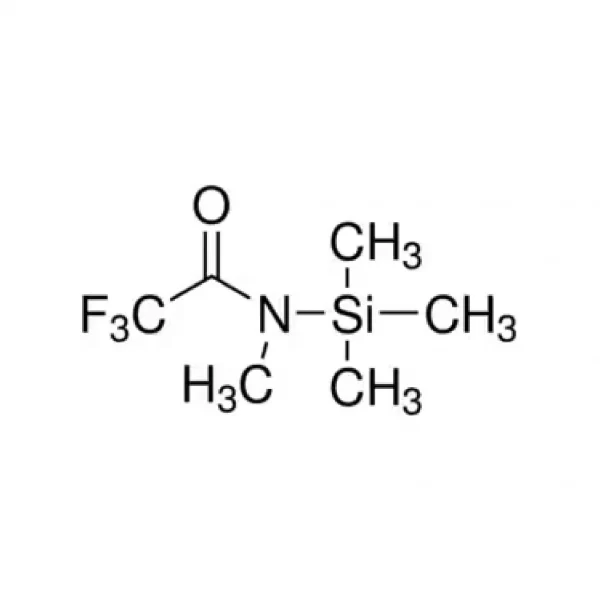
N-Methyl-N-(trimethylsilyl)trifluoroacetamide for GC derivatization, LiChropur™, ≥98.5% (Sigma)
Login to see pricesBrand:
Sigma
Description
N-Methyl-N-(trimethylsilyl)trifluoroacetamide (MSTFA) is a silylating reagent.

N,N-Dimethylacetamide, ReagentPlus®, 99% (Sigma-Aldrich)
Login to see pricesBrand:
Sigma-Aldrich
General Description
CAS number: 127-19-5
Chemical Formula: CH3CON(CH3)2
Molar Mass: 87.12 g/mol

Phorbol 12-myristate 13-acetate, ≥99% (TLC, Sigma-Aldrich)
Login to see pricesBrand:
Sigma-Aldrich
Description
CAS number: 16561-29-8
Chemical Formula: C36H56O8
Molar Mass: 616.83g/mol
Synonyms: 12-O-Tetradecanoylphorbol 13-acetate, 4β,9α,12β,13α,20-Pentahydroxytiglia-1,6-dien-3-one 12-tetradecanoate 13-acetate, PMA, TPA
General description
Phorbol 12-myristate 13-acetate is a phorbol ester. It works as a tumour promoter and is involved in gene transcription, cell growth, differentiation, programmed cell death, immune pathway and receptor desensitization via protein kinase C (PKC) signalling pathways. Phorbol 12-myristate 13-acetate is also a model agent to study growth factors-, hormones-, and cytokines-mediated regulation of cellular growth and differentiation.
Application
Phorbol 12-myristate 13-acetate has been used for the stimulation of various cells including spleen cells, quiescent lymphocytes and fetal thymocytes. It has also been used for the activation of PKC (protein kinase C) in cells.
Solubility
DMSO: soluble (Dissolve in water-miscible organic solvent prior to preparing aqueous solutions. DMSO solutions can be stored dark at -20 °C for at least six months.)
Ethanol: soluble (Dissolve in water-miscible organic solvent prior to preparing aqueous solutions.)
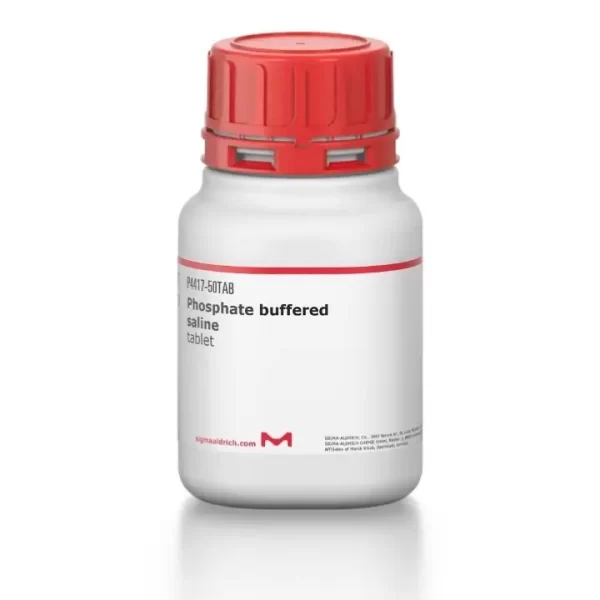
Phosphate buffered saline (Sigma-Aldrich)
Login to see pricesBrand:
Sigma
Description
CAS Number : 24867-26-3
Phosphate-buffered saline (PBS) is a buffer solution used in biological research. It is a water-based salt solution containing sodium phosphate, sodium chloride and, in some formulations, it contains potassium chloride and potassium phosphate. The osmolality and ion concentrations of the solutions match those of the human body (isotonic) and are non-toxic to most cells.
Application :
- For the production of platinum nanoparticles (NP-Pt) hydrocolloids
- For the washing of blood sample and SEM (scanning electron microscope) stubs prior to SEM
- For preparing the solution of fluorescent lectin wheat germ agglutinin (WGA)
- For the dilution of capture antibody during ELISA (enzyme linked immunosorbent assay)
- For suspension of cell pellets during centrifugation
- In immunoassay procedures.
One tablet dissolved in 200 mL of deionized water yields 0.01 M phosphate buffer, 0.0027 M potassium chloride and 0.137 M sodium chloride, pH 7.4, at 25 °C.


